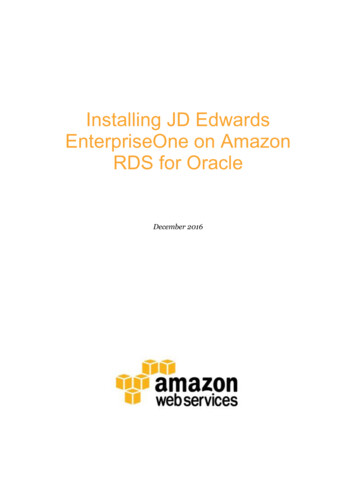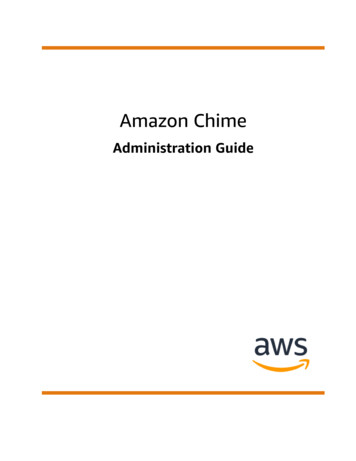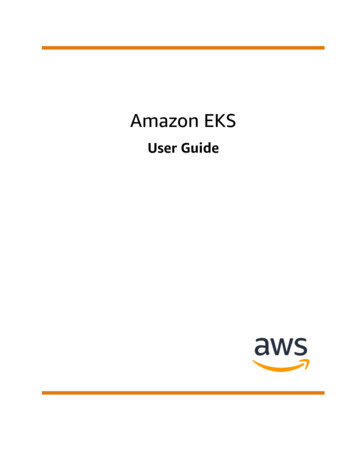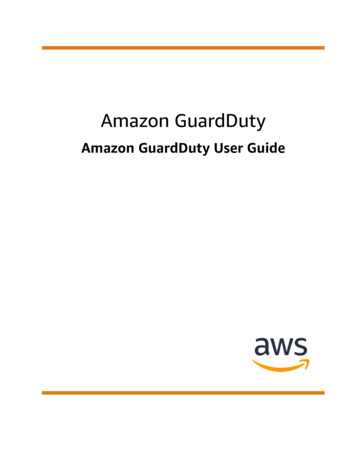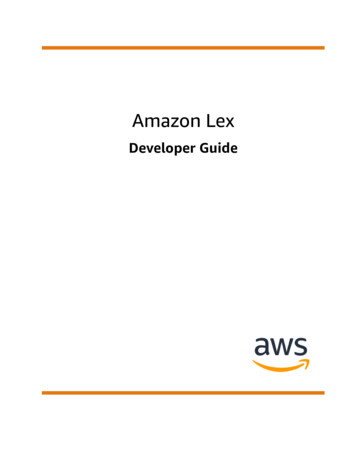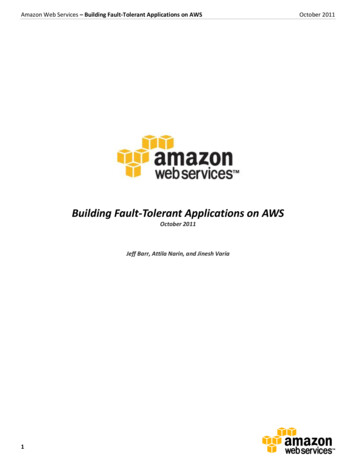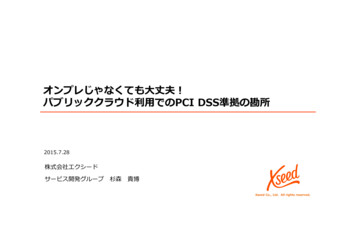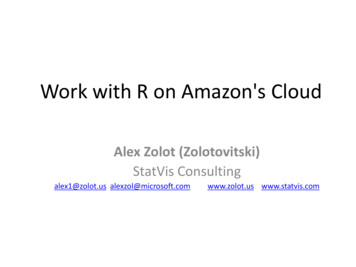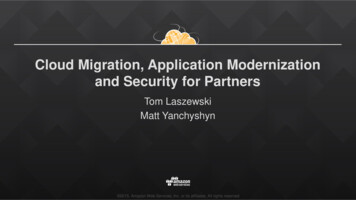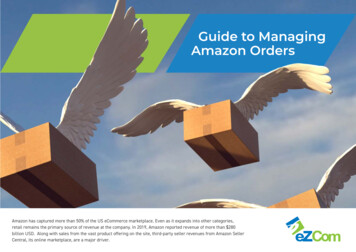
Transcription
Guide to ManagingAmazon OrdersAmazon has captured more than 50% of the US eCommerce marketplace. Even as it expands into other categories,retail remains the primary source of revenue at the company. In 2019, Amazon reported revenue of more than 280billion USD. Along with sales from the vast product offering on the site, third-party seller revenues from Amazon SellerCentral, its online marketplace, are a major driver.
2TABLE OFCONTENTSIntroduction. 03Vendor Central .09Which Amazon?. 04Managing EDI. 11Seller Central. 05Direct Fulfillment. 14FBM. 07ERP Integration. 15FBA. 08Global Selling. 16G U I D ET OM A N A G I N GA M A Z O NO R D E R S
3THE AMAZON QUESTION.Once you start selling products online,you will inevitably face a decision.“eCommerce has evolved in the last 20years, but it was Amazon that did the mostto alter how we buy, sell, and transact. Ithas been among the most innovative, andclaims most of the eCommerce market.”— Allison Schrager, Quartz Newsletter“Do we sell on Amazon? Or not?”When it comes to online marketplaces, there’s noquestion Amazon is in a class by itself. No otherretailer has its volume or reach, and few use dataand technology as effectively.But it’s not without well-documented challenges.As dominant as it is—more than 60% of consumersnow begin their online shopping searches on it—Amazon is not for everyone.There are challenges. You’ll give up somemeasure of control, margins can be tight, and it’sextremely competitive.Just like it can be difficult to gain attention whenyour products are on a retailer’s shelf, it is noteasy to attract a following among the millions—billions?—of products for sale on the site. It’s aserious undertaking, and many brands have staffdedicated solely to marketing and managing theirproducts on Amazon.G U I D ET OM A N A G I N GA M A Z O NO R D E R SBottom line: it takes effort and commitment tosucceed on Amazon.If you decide you want a piece of the action onAmazon, more decisions await. Specifically, whichAmazon do you want to be on?
4WHICH AMAZON?I THOUGHT THERE WASONLY ONE AMAZON.It may seem like it’s one Amazon to shoppers.But sellers will face all kinds of choices.Products may be offered on Amazon through:1Seller Central with Fulfilled by Merchant (FBM)2Seller Central with Fulfilled by Amazon (FBA)3Vendor Central4Vendor Central Direct FulfillmentG U I D ET OM A N A G I N GA M A Z O NO R D E R S
5SELLER CENTRALThis is the Amazon launching point for many sellers. A true onlinemarketplace, brands on Seller Central list their products themselves,establish prices, tackle marketing and promotion, and provide product copyand images. Companies that have products listed through Amazon SellerCentral can choose Fulfilled by Merchant (FBM) or Fulfilled by Amazon(FBA). With FBM, the seller assumes all the responsibility for gettingproducts shipped when there is an order. With FBA, sellers ship theirproducts to a distribution center and Amazon fulfills the order.What are the challenges? With Seller Central, all order processing responsibility lies with thesupplier. If you’re a FBM seller, you need to ship all merchandise yourself, andAmazon has specific guidelines for fulfilling orders. To integrate or connect another system to Seller Central with an API,you need to be an Amazon-approved developer. Without the right software, suppliers are forced to log into multipleportals—Amazon, shipping providers, etc. Processing a lot of single-item orderscan be very time-consuming—it’snot like the wholesale model anddemands a different approach. All those direct-to-consumer orders add challenges to shipping—you’llneed to generate labels efficiently and make sure they’re error-free. You need to ensure that your inventory is updated. Very few FBM sellers are approved for Amazon Prime. That usuallyrequires FBA.G U I D ET OM A N A G I N GA M A Z O NO R D E R S If you are an FBM seller and you are approved for Amazon Prime, you’llneed to ship with Amazon-brandedpacking slips and labels.
6WHY USE LINGO FROM EZCOM? Process in bulk instead of one-at-a-time,including direct-to-consumer orders, making iteasier to manage large sales volume. Connect directly to Amazon through Lingo—noneed to switch to the Amazon portal as youprocess orders. Get easy API connections—we are an Amazonapproved developer. Connect directly to the major shippingproviders to eliminate the need for timeconsuming manual entry of information.Automate label creation to process hundredsof single-item orders in bulk instead of one ata time—a major advantage for FBM suppliers.Provide a 3PL partner with necessaryshipping details through Lingo, whilepreventing access to any confidential financialinformation in your Amazon account. Make inbound shipments to Amazon easy, andautomatically generate tracking information. Provide real-time inventory updates toAmazon. Save time with seamless Amazon integration.Inbound Shipments for FBAGenerate shipping labels, and inform your warehouse when goods need to be picked,packed, and shipped to an Amazon distribution center—Lingo makes it easy forcompanies that use FBA.Sellers can use our API to develop their own document flow and connect Amazon withtheir warehouse. If an ERP powers the business, it can be integrated with Lingo tocreate and communicate inventory transfers.G U I D ET OM A N A G I N GA M A Z O NO R D E R S
7AMAZON FBMWith Lingo, managing FBM orders can be done alongside EDI transactions,using the same process.All orders, from one-off purchases made on Seller Central to large-volumewholesale orders from traditional retailers, are received through Lingo. Youcan choose how to receive notifications—most of our users choose automatedemails.Once in Lingo, you can quickly see all the orders that are ready to review andprocess. If it’s a Seller Central order, you’ll send Pick tickets from Lingo toyour warehouse and be able to connect directly with shipping providers toAmazon Seller CentralPetcoChewyG U I D ET OM A N A G I N GA M A Z O NO R D E R Sautomate data transfer. That eliminates copy-and-paste actions, and the errorsthey routinely produce. The transfer of tracking information back to Amazon isalso automated.Guess what? That process you use to process a single order is the same oneyou’ll use for large EDI orders with retailers. It also works in bulk, so you canprocess hundreds of orders with just a few clicks.
8AMAZON FBAWith eZCom and Lingo, it's easy to process FBA orders on the sameplatform that you use for orders from a retailer like Nordstrom orpurchases made through your company's Shopify store.In Lingo, you can quickly complete a Stock Transfer Order and move inventoryfrom your warehouse or 3PL facility to an Amazon distribution center. AfterAmazon has stock, you’ll still want visibility. With Lingo, you can quickly seehow many items have sold, and send more inventory as necessary. When neworders come in, you can be confident the stock is available and ready to beFulfilled by Amazon.Of course, you’re likely to have orders from channels beyond Amazon SellerCentral. For example, if you sell to a major retailer such as Nordstrom, youwill need to be EDI-compliant. But you may also process orders from your ownShopify or eCommerce store. Instead of logging into multiple portals—timeconsuming and more opportunities for errors—you can process all your ordersthe same way through Lingo. If you expand and add more retail channels,it’s easy to scale or create even more efficiency by integrating with an ERP,accounting software, or WMS.Amazon FulfillmentAmazon Seller CentralNordstromInventory softwareAccounting System ERPShopifyG U I D ET OM A N A G I N GA M A Z O NO R D E R S
9VENDOR CENTRALVendor Central follows the wholesale model. Brands sell their productsto Amazon and, after that, the online giant manages just about everythingelse—pricing, discounting or bundling with other products, and fulfillment.With Vendor Central, sellers need to use EDI (EDIfact for EU countries), andcomply with the standards and requirements of Amazon. EDI software is amust.What are the challenges? Vendor Central requires compliance with the EDI standards of Amazon.Managing EDI orders with in-house staff can be expensive, timeconsuming, and have a significant learning curve. You will need to regularly update your EDI mapping as Amazon changesrequirements regularly. You will need to complete EDI testing. You will be required to print GS1-128 labels, along with shipping labels. It can be very time-consuming—you may be forced to process ordersone at a time. Amazon will most likely dictate how you must ship the order, and youwill need to add this data to your EDI 856. If you rely on copy-and-paste,the process is slow, error-prone, and likely to cause chargebacks. If you are getting orders from lots of places, it can be challenging tomanage multiple portals and any manual transfer of data can produceerrors.G U I D ET OM A N A G I N GA M A Z O NO R D E R SVendor Central is how most larger, multinational brands sell on Amazon.Smaller brands that demonstrate success on Seller Central are ofteninvited to Vendor Central, and truly unique, high-demand products may godirectly into this channel.
10WHY USE EZCOM? Connect directly to Amazon through our Lingosoftware. Sell with confidence—Lingo is robust and wehave a proven track record of maintaining EDIcompliance with Amazon.Receive insight from our experts that willhelp you manage and complete testing withAmazon. Get the support of a team with extensiveexperience in all the documents that Amazonrequires.Connect and process orders from otherretailers and online stores using the sameapproach that you do with Amazon. Integrate with another system such as an ERP,accounting software, or WMS.“We forecast that Amazon’s 2020 US retailecommerce sales will rise 17.2% to 260.86billion—four percentage points higher thanthe expected overall growth rate for US retaileCommerce sales.”— eMarketerG U I D ET OM A N A G I N GA M A Z O NO R D E R S
11MANAGING THE EDIPROCESS WITH AMAZON.Remember that no two companies are alike. Yoursis unique, and you need to establish an Amazonworkflow that lets you process orders in less timeand avoid mistakes that cost you money.The best process will be automated as much aspossible. Automation lets you complete manytedious tasks in far less time, and avoid the errorsthat are common when data is entered manually.EDI Documents Used by Amazon 850 (Purchase Order)When is the GS1 Prefix used? 855 (Purchase Order Acknowledgment) 856 (Advanced Shipment Notice) 810 (Invoice) 846 (Inventory Advice/Update) is optional butrequired for D2C 753 (Request for Routing Instructions) isoptionalThe most common use of a GS1 prefix is as a basisfor assigning UPCs to products, however, GS1prefixes are also used in EDI. The main function itserves for EDI is as a basis for assigning a uniqueSerial Shipping Container Code (also known asSSCC-18) number to the GS1-128 carton labelsyou must affix to each of your cartons whenshipping as an EDI compliant vendor. 754 (Routing Instructions) is optional 852 (Product Activity Data) is optional GS1- 128G U I D ET OM A N A G I N GA M A Z O NO R D E R S
12SAMPLE WORKFLOW:AMAZON VENDOR CENTRALCompany A receives an EDI 850 (Purchase Order) from Amazon. Company Areviews the order and returns an EDI 855 (Purchase Order Acknowledgement)to confirm with Amazon that the order has been received. Once that is done,Company A will pick-and-pack the order. Without leaving the Lingo platform,Company A will connect with the shipping provider to generate shippinglabels. Company A will send the EDI 856 (Advanced Shipping Notice or ASN) toAmazon to provide the following information: what the shipment includes, howOrder850 POAcknowledgeOrder855 POAShipment NoticeReceived856 ASNInvoice Receivedit is being shipped, and when it will be shipped. Tracking numbers will also beincluded in this data set. When the ASN is transmitted, Lingo can automaticallygenerate the EDI 810 (Invoice) that Company A sends. All of these steps can becompleted for a single order, or thousands of orders can be completed in justa few clicks with bulk processing.Order ReceivedFulfillmentInvoice810 INVOICEG U I D ET OM A N A G I N GA M A Z O NO R D E R S
13SAMPLE WORKFLOW:AMAZON VENDOR CENTRALCompany B receives an EDI 850 (Purchase Order) from Amazon. Company Breturns an EDI 855 (Purchase Order Acknowledgement) to confirm with Amazonthat the order has been received. After reviewing the order, Company B sends anEDI 753 (Request for Routing) that asks Amazon how this order should be shipped.Amazon returns an EDI 754 (Routing Instructions) with the necessary details.Company B sends an EDI 940 (Warehouse Shipping Order) to their 3PL providerso the pick-and-pack begins. The 3PL provider returns an EDI 945 (WarehouseShipping Advice) to confirm the shipment and inform Company B that the EDI 856(Advanced Shipping Notice or ASN) can be sent. All the details about the order,including tracking data for the shipment, is automated and populates the ASN.Order PlacedAcknowledgeOrderRouting RequestShipment NoticeReceivedInvoice Received850 POCompany B also needs to keep inventory updated regularly in the Amazonsystem. Company B has multiple SKUs so logging into the Amazon systemand updating each item would be very time-consuming. Instead, Company Bcompletes inventory updates in bulk with the EDI 846. Updates can be doneat any time depending upon the relationship and volume sold on Amazon—Company B automates the process so it occurs weekly.855 POAOrderProcessed753Request forRouting754856 ASN810 invoice846InventoryUpdatedSince Company B uses bulk processing, the creation and transmission of the EDI810 (Invoice) is automated. Lingo generates it based on the ASN, so any changesto the order are reflected in the EDI 810.WarehouseOrder940945Pick PackShipmentInvoiceInventoryUpdateWAREHOUSE/3PLG U I D ET OM A N A G I N GA M A Z O NO R D E R S
14VENDOR CENTRALDIRECT FULFILLMENTCompanies that are Amazon Vendor Central suppliers may also need toprocess orders with Direct Fulfillment. If an item is not available at anAmazon distribution center, Amazon may continue to accept online ordersfor it. When this occurs, the supplier is required to fulfill the order and shipdirect-to-consumer. Once the inventory of that item is replenished at thedistribution center, Amazon resumes order fulfillment responsibilities.What are the challenges? Products appear as “Sold by Amazon” and suppliers will need to deliverthe kind of seamless experience Amazon customers have come toexpect.While shipping is paid for by Amazon, you must pick, pack, and fulfill theorder. The supplier will need to ship with Amazon-branded labels and packingslips. The supplier is still required to send all EDI data, including trackingnumbers, to Amazon. A reliance on manual entry of data will lead to errors. Connect directly to shipping providers from Lingo to automate thetransfer of information.Amazon shipping times are famously fast—the supplier needs to matchthem.Why Use eZCom? Generate Amazon-branded labels and packing slips on the sameplatform you rely on to transmit EDI documents. Process labels and packing slips in bulk—completing this task quicklymakes it easier to meet the deliver-by standards for shipping thatAmazon enforces.G U I D ET OM A N A G I N GA M A Z O NO R D E R S
15WORKING IN AN ERPSeamless integration of our Lingo software with most ERPs sets eZCom apart.You can choose a pre-built connector, a custom solution developed by our inhouse team, or develop your own document flow with our API.We start with a Discovery Process to determine the optimal workflow. Someusers prefer to work partly in Lingo and partly in their ERP, while others wantto work only in their ERP. When companies elect to work solely in the ERP,Lingo serves as a control center. If issues appear, our software can be used totrace the data and resolve them.EDIG U I D ET OM A N A G I N GA M A Z O NO R D E R SWith Lingo integrated with your ERP, it’s easy to connect all your saleschannels, and process everything the same way, whether it’s an AmazonSeller Central order or the exchange of EDI documents with a brick-andmortar retailer. Your ERP will be more robust, data will be far easier tomanage, and greater efficiencies will be achieved.API
16AMAZON GLOBAL SELLINGAmazon Global Selling lets you sell products around the world, offering accessto additional markets, including Europe, Japan, Australia, and Brazil. Mostsuppliers generally sell only within their market, but Amazon provides sellerswith tools and services that simplify international expansion. It does, however,add complexity to order processing, so companies need to be sure they have asystem that can adapt and scale as they expand into new markets. Amazon Advantage Amazon Spain Amazon Australia Amazon UK Amazon Canada Amazon ChinaAmazon United ArabEmirates Amazon France Amazon UnitedStates Amazon DirectFulfillment Amazon Germany Amazon Italy Amazon Mexico Amazon Middle East& North Africa Amazon NetherlandsG U I D ET OM A N A G I N GA M A Z O NO R D E R S
17SHOULD I COMMIT TO AMAZON?Amazon offers many great features to help sellers succeed, and smartcompanies take advantage of them. But it’s not always straightforward tomeet their requirements, and the sheer volume can be challenging. Insteadof shipping one large wholesale order to a retailer, you can find yourselfsending hundreds or even thousands of single item purchases. Each one willhave a different address, of course, and the opportunities for costly mistakescompound. Without the right system or software in place, the demands onyour time will also quickly grow.Amazon is also very competitive, and places a real premium on the feedbackof customers. When a shipment arrives late or damaged or is unavailableLET'S CONNECT.We would welcome the opportunity to discuss how we can help you makeAmazon order processing less time-consuming and more cost-effective.To get the conversation started, send an email to sales@ezcomsoftware.comor call us at 201-731-1800 and select Option 1.G U I D ET OM A N A G I N GA M A Z O NO R D E R Sbecause of an inventory shortage, there’s a good chance the buyer will leavea less-than-positive review. Too many negative reviews will not only hurt yourchances of making new sales to prospective buyers, but they can also causeAmazon to remove you from the site. In other words, your product may beincredible, but if you don’t have seamless, error-free order management, yoursales numbers are going to take a serious hit.Still, countless brands, large and small, have grown their business through apresence on Amazon. With Lingo, you can manage orders and take advantageof this important marketplace in an efficient, profitable way.
HOW TOCONNECT25 Rockwood Place, Suite 420Englewood, NJ 07631201 - 731 - 1800877 - 765 - 3564Sales@eZComsoftware.com
Company A receives an EDI 850 (Purchase Order) from Amazon. Company A . reviews the order and returns an EDI 855 (Purchase Order Acknowledgement) to confirm with Amazon that the order has been received. Once that is done, Company A will pick-and-pack the order. Without leaving the Lingo platform,

![Index [beckassets.blob.core.windows ]](/img/66/30639857-1119689333-14.jpg)
